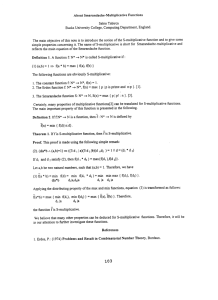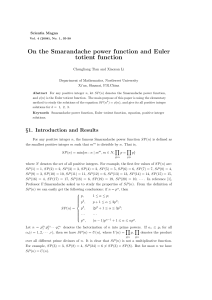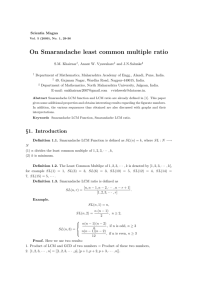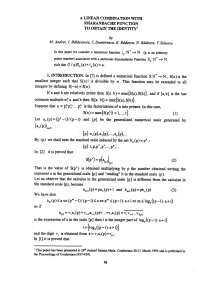SMARANDACHE BCC-ALGEBRAS
advertisement
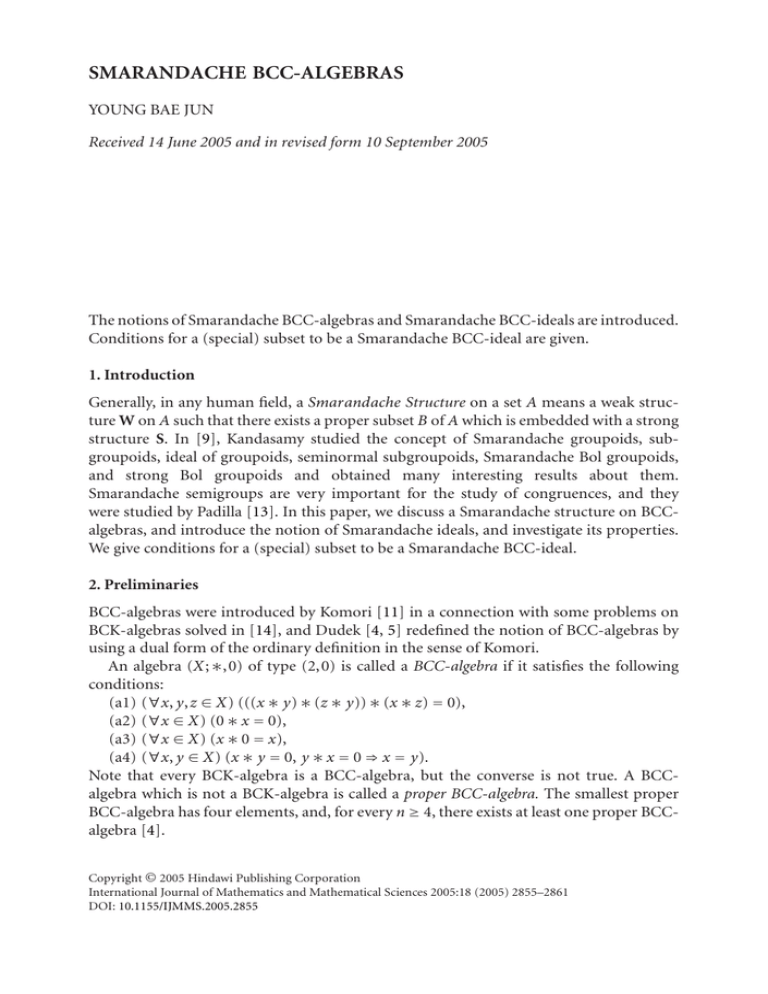
SMARANDACHE BCC-ALGEBRAS
YOUNG BAE JUN
Received 14 June 2005 and in revised form 10 September 2005
The notions of Smarandache BCC-algebras and Smarandache BCC-ideals are introduced.
Conditions for a (special) subset to be a Smarandache BCC-ideal are given.
1. Introduction
Generally, in any human field, a Smarandache Structure on a set A means a weak structure W on A such that there exists a proper subset B of A which is embedded with a strong
structure S. In [9], Kandasamy studied the concept of Smarandache groupoids, subgroupoids, ideal of groupoids, seminormal subgroupoids, Smarandache Bol groupoids,
and strong Bol groupoids and obtained many interesting results about them.
Smarandache semigroups are very important for the study of congruences, and they
were studied by Padilla [13]. In this paper, we discuss a Smarandache structure on BCCalgebras, and introduce the notion of Smarandache ideals, and investigate its properties.
We give conditions for a (special) subset to be a Smarandache BCC-ideal.
2. Preliminaries
BCC-algebras were introduced by Komori [11] in a connection with some problems on
BCK-algebras solved in [14], and Dudek [4, 5] redefined the notion of BCC-algebras by
using a dual form of the ordinary definition in the sense of Komori.
An algebra (X; ∗,0) of type (2,0) is called a BCC-algebra if it satisfies the following
conditions:
(a1) (∀x, y,z ∈ X) (((x ∗ y) ∗ (z ∗ y)) ∗ (x ∗ z) = 0),
(a2) (∀x ∈ X) (0 ∗ x = 0),
(a3) (∀x ∈ X) (x ∗ 0 = x),
(a4) (∀x, y ∈ X) (x ∗ y = 0, y ∗ x = 0 ⇒ x = y).
Note that every BCK-algebra is a BCC-algebra, but the converse is not true. A BCCalgebra which is not a BCK-algebra is called a proper BCC-algebra. The smallest proper
BCC-algebra has four elements, and, for every n ≥ 4, there exists at least one proper BCCalgebra [4].
Copyright © 2005 Hindawi Publishing Corporation
International Journal of Mathematics and Mathematical Sciences 2005:18 (2005) 2855–2861
DOI: 10.1155/IJMMS.2005.2855
2856
Smarandache BCC-algebras
A nonempty subset I of a BCC-algebra X is called a BCC-ideal of X if it satisfies the
following assertions:
(a5) 0 ∈ I,
(a6) (∀x,z ∈ X) (∀ y ∈ I) ((x ∗ y) ∗ z ∈ I ⇒ x ∗ z ∈ I).
Note that every BCC-algebra X satisfies the following assertions:
(b1) (∀x ∈ X) (x ∗ x = 0),
(b2) (∀x, y ∈ X) (x ∗ y ≤ x),
(b3) (∀x, y,z ∈ X) (x ≤ y ⇒ x ∗ z ≤ y ∗ z, z ∗ y ≤ z ∗ x),
where x ≤ y if and only if x ∗ y = 0.
3. Smarandache BCC-algebras
We know that every proper BCC-algebra has at least four elements (see [4]), and that if X
is a BCC-algebra, then {0,a}, a ∈ X, is a BCK-algebra with respect to the same operation
on X. Now let us consider a proper BCC-algebra X = {0,1,2,3,4} with the following
Cayley table:
∗
0
1
2
3
4
0
0
1
2
3
4
1
0
0
2
3
0
2
0
1
0
1
0
3
0
0
1
0
0
4
0
1
2
3
0
(3.1)
Then {0,1}, {0,2}, {0,3}, {0,4}, {0,1,2}, and {0,1,3} are BCK-algebras with respect
to the operation ∗ on X, and note that X does not contain BCK-algebras of order 4. Based
on this result, we give the following definition.
Definition 3.1. A Smarandache BCC-algebra (briefly, S-BCC-algebra) is defined to be a
BCC-algebra X in which there exists a proper subset Q of X such that
(i) 0 ∈ Q and |Q| ≥ 4,
(ii) Q is a BCK-algebra with respect to the same operation on X.
Note that any proper BCC-algebra X with four elements cannot be an S-BCC-algebra.
Hence, if X is an S-BCC-algebra, then |X | ≥ 5. Notice that the BCC-algebra X = {0,1,2,3,
4} with Table 3.1 is not an S-BCC-algebra.
Example 3.2. (1) Let X = {0,a,b,c,d,e} be a set with the following Cayley table:
∗
0
a
b
c
d
e
0 a
0 0
a 0
b b
c b
d d
e e
b
0
0
0
a
d
e
c
0
0
0
0
d
e
d
0
0
a
a
0
e
e
0
a
a
a
a
0
(3.2)
Young Bae Jun 2857
Then, (X; ∗,0) is an S-BCC-algebra. Note that Q = {0,a,b,c} is a BCK-algebra which
is properly contained in X.
(2) Let (X; ∗,0) be a finite BCK-chain containing at least four elements, and let c be its
/ X, and define a binary operation on Y
maximal element. Let Y = X ∪ {d}, where d ∈
as follows:
x∗y
0
xy =
d
c
if x, y ∈ X,
if x ∈ Y , y = d,
if x = d, y = 0,
if x = d, y ∈ X.
(3.3)
Then, (Y ; ,0) is an S-BCC-algebra.
(3) Let (X; ∗,0) be a BCK-algebra containing at least four elements in which a is the
/ X, and define a binary operation on Y as
small atom. Let Y = X ∪ {w}, where w ∈
follows:
x ∗ y
w
x y = 0
0
a
if x, y ∈ X,
if y ∈ X, x = w,
if x = 0, y = w,
if x = w = y,
if x ∈ X \ {0}, y = w.
(3.4)
Then, (Y ; ,0) is an S-BCC-algebra.
In what follows, let X and Q denote an S-BCC-algebra and a nontrivial BCK-algebra
which is properly contained in X, respectively, unless otherwise specified.
Definition 3.3. A nonempty subset I of X is called a Smarandache BCC-ideal (briefly,
S-BCC-ideal) of X related to Q if it satisfies the following:
(c1) 0 ∈ I,
(c2) (∀x,z ∈ Q) (∀ y ∈ I) ((x ∗ y) ∗ z ∈ I ⇒ x ∗ z ∈ I).
If I is an S-BCC-ideal of X related to every nontrivial BCK-algebra Q contained in X, we
simply say that I is an S-BCC-ideal of X.
Example 3.4. Let X = {0,a,b,c,d,e} be the S-BCC-algebra described in Example 3.2(1).
Then, I = {0,a} and J = {0,a,b,c,d} are S-BCC-ideals of X related to Q = {0,a,b,c}.
Proposition 3.5. Every S-BCC-ideal I of X related to Q satisfies the following:
(c3) (∀x ∈ Q) (∀a ∈ I) (x ∗ a ∈ I ⇒ x ∈ I).
(c4) (∀x ∈ Q) (∀a ∈ I) (a ∗ x ∈ I).
(c5) (∀x ∈ Q) (∀a,b ∈ I) (x ∗ ((x ∗ a) ∗ b) ∈ I).
Proof. (c3) Taking z = 0 and y = a in (c2) and using (a3) induce the desired implication.
(c4) For every x ∈ Q and a ∈ I, we have (a ∗ a) ∗ x = 0 ∗ x = 0 ∈ I, and so a ∗ x ∈ I
by (c2).
2858
Smarandache BCC-algebras
(c5) Let x ∈ Q and a,b ∈ I. Then, (x ∗ a) ∗ (x ∗ a) = 0 ∈ I, and so x ∗ (x ∗ a) ∈ I by
(c2). Since
(x ∗ b) ∗ (x ∗ a) ∗ b
∗ x ∗ (x ∗ a) = 0 ∈ I,
(3.5)
it follows from (c3) that (x ∗ b) ∗ ((x ∗ a) ∗ b) ∈ I, so from (c2) that x ∗ ((x ∗ a) ∗ b) ∈ I.
Corollary 3.6. For every S-BCC-ideal I of X related to Q, the following implication is
valid:
(∀x ∈ Q) (∀a ∈ I)
(x ≤ a =⇒ x ∈ I).
(3.6)
Corollary 3.7. Let I be an S-BCC-ideal of X relative to Q. Then,
(x ∗ a ≤ b =⇒ x ∈ I).
(∀x ∈ Q) (∀a,b ∈ I)
(3.7)
Theorem 3.8. Let Q1 and Q2 be nontrivial BCK-algebras which are properly contained in
X such that Q1 ⊂ Q2 . Then, every S-BCC-ideal of X related to Q2 is an S-BCC-ideal of X
related to Q1 .
Proof. Straightforward.
Corollary 3.9. If Q is the largest BCK-algebra which is properly contained in X, then every
S-BCC-ideal of X related to Q is an S-BCC-ideal of X.
The converse of Theorem 3.8 is not true in general as seen in the following example.
Example 3.10. Consider an S-BCC-algebra X = {0,1,2,3,4,5} with the following Cayley
table:
∗
0
1
2
3
4
5
0
0
1
2
3
4
5
1
0
0
1
1
1
5
2
0
0
0
1
1
5
3
0
0
0
0
1
5
4
0
0
0
1
0
5
5
0
1
1
1
1
0
(3.8)
Note that Q1 := {0,1,2,3} and Q2 := {0,1,2,3,4} are BCK-algebras. Then, the set Q1 is
an S-BCC-ideal of X related to Q1 , but not Q2 . In fact, we know that (4 ∗ 2) ∗ 0 = 1 ∈ Q1
and 4 ∗ 0 = 4 ∈
/ Q1 .
Remark 3.11. Note that every BCC-ideal of X is an S-BCC-ideal of X, but the converse is
not valid. Example 3.10 shows that there exists a BCK-algebra Q of order n ≥ 4, which is
properly contained in an S-BCC-algebra X such that an S-BCC-ideal of X related to Q is
not a BCC-ideal of X.
We provide conditions for a subset to be an S-BCC-ideal.
Young Bae Jun 2859
Theorem 3.12. If I is a subset of Q that satisfies conditions (c1) and (c3), then I is an
S-BCC-ideal of X related to Q.
Proof. Let x, y ∈ Q and a ∈ I be such that (x ∗ a) ∗ y ∈ I. Since a ∈ I ⊆ Q and Q is a
BCK-algebra, it follows that (x ∗ y) ∗ a = (x ∗ a) ∗ y ∈ I, so from (c3) that x ∗ y ∈ I.
Hence, I is an S-BCC-ideal of X related to Q.
Theorem 3.13. If a nonempty subset I of X satisfies conditions (c1) and (c5), then I is an
S-BCC-ideal of X related to Q.
Proof. Let x, y ∈ Q and a ∈ I be such that (x ∗ a) ∗ y ∈ I. Taking b = 0 in (c5), and using
(a3), we have x ∗ (x ∗ a) ∈ I. It follows from (a3), (a1), and (c5) that
x ∗ y = (x ∗ y) ∗ 0 = (x ∗ y) ∗
(x ∗ y) ∗ (x ∗ a) ∗ y
∗ x ∗ (x ∗ a) ∈ I.
(3.9)
Thus, I is an S-BCC-ideal of X related to Q.
Theorem 3.14. Let H be a BCC-subalgebra of X. Then, H is an S-BCC-ideal of X related
to Q if and only if it satisfies the following:
(∀x ∈ H) (∀ y,z ∈ Q)
(y ∗ x) ∗ z ∈ H =⇒ y ∗ z ∈ H .
(3.10)
Proof. Straightforward.
Given an element w ∈ X \ {0}, consider the set
[0,w] := {x ∈ X | x ≤ w},
(3.11)
which is called the initial segment of w [7]. Obviously, 0 ∈ [0,w] for all w ∈ X. Since
x ≤ w is equivalent to xw = 0, the initial segment of w is de facto the left annihilator of
w. In general, [0, w] is not an S-BCC-ideal of X, but it is a subalgebra. For example, let X
be the S-BCC-algebra in Example 3.2(1). Then, [0,e] = {0,e} is not an S-BCC-ideal of X
/ [0,e].
related to Q = {0,a,b,c} since (b ∗ e) ∗ d = 0 ∈ [0,e], but b ∗ d = a ∈
Theorem 3.15. For every c ∈ X \ {0}, if the inequality
(∀x ∈ Q)
x ∗ (x ∗ c) ∗ c ≤ c
(3.12)
holds, then [0,c] is an S-BCC-ideal of X related to Q.
Proof. Let x ∈ Q. If b ∈ [0,c], then b ≤ c and hence (x ∗ c) ∗ c ≤ (x ∗ c) ∗ b by (b3). It
follows from (b3) and assumption that
x ∗ (x ∗ c) ∗ b ≤ x ∗ (x ∗ c) ∗ c ≤ c.
(3.13)
Now if a ∈ [0,c], then x ∗ c ≤ x ∗ a, and so
x ∗ (x ∗ a) ∗ b ≤ x ∗ (x ∗ c) ∗ b ≤ c.
(3.14)
This shows that x ∗ ((x ∗ a) ∗ b) ∈ [0,c]. Applying Theorem 3.13, we conclude that [0,c]
is an S-BCC-ideal of X related to Q.
2860
Smarandache BCC-algebras
Theorem 3.16. The initial segment [0,c], where c ∈ X \ {0}, is an S-BCC-ideal of X related
to Q if and only if the implication
(∀x, y ∈ Q)
(x ∗ c) ∗ y ≤ c =⇒ x ∗ y ≤ c
(3.15)
is valid.
Proof. Let x, y ∈ Q and a ∈ [0,c] be such that (x ∗ a) ∗ y ∈ [0,c]. Then, a ≤ c and (x ∗
a) ∗ y ≤ c. The inequality a ≤ c implies that (x ∗ c) ∗ y ≤ (x ∗ a) ∗ y ≤ c, so from hypothesis that x ∗ y ≤ c, that is, x ∗ y ∈ [0,c]. Therefore, [0, c] is an S-BCC-ideal of X
related to Q. Conversely assume that [0, c], c ∈ X \ {0}, is an S-BCC-ideal of X related to
Q, and let x, y ∈ Q be such that (x ∗ c) ∗ y ≤ c. Then, (x ∗ c) ∗ y ∈ [0,c]. Since [0,c] is
an S-BCC-ideal of X related to Q and c ∈ [0,c], it follows from (c2) that x ∗ y ∈ [0,c] so
that x ∗ y ≤ c. This completes the proof.
Corollary 3.17. If [0,c], c ∈ X \ {0}, is an S-BCC-ideal of X related to Q, then
(x ∗ c ≤ c =⇒ x ≤ c).
(∀x ∈ Q)
(3.16)
Theorem 3.18. For every c ∈ X \ {0}, if the equality
(∀x, y ∈ Q)
(x ∗ c) ∗ y ∗ c = (x ∗ y) ∗ c
(3.17)
is valid, then [0,c] is an S-BCC-ideal of X related to Q.
Proof. Let x, y ∈ Q and a ∈ [0,c] be such that (x ∗ a) ∗ y ∈ [0,c]. Then, a ≤ c and (x ∗
a) ∗ y ≤ c. It follows that
(x ∗ y) ∗ c = (x ∗ c) ∗ y ∗ c ≤ (x ∗ a) ∗ y ∗ c ≤ c ∗ c = 0,
(3.18)
so that (x ∗ y) ∗ c = 0, that is, x ∗ y ≤ c. Hence, x ∗ y ∈ [0,c] and therefore [0,c] is an
S-BCC-ideal of X related to Q.
Acknowledgments
The author is highly grateful to referees for their valuable comments and suggestions
which were helpful in improving this paper. This paper was supported by Korea Research
Foundation Grant (KRF-2003-005-C00013).
References
[1]
[2]
[3]
[4]
[5]
P. J. Allen, H. S. Kim, and J. Neggers, Smarandache disjoint in BCK/D-algebras, Sci. Math. Jpn.
61 (2005), no. 3, 447–449.
, Super commutative D-algebras and BCK-algebras in the Smarandache setting, Sci.
Math. Jpn. 62 (2005), no. 1, 131–135.
W. A. Dudek, On constructions of BCC-algebras, Selected Papers on BCK and BCI-algebras 1
(1992), 93–96, Shaanxi Scientific and Technological Press, Xian, China.
, On proper BCC-algebras, Bull. Inst. Math. Acad. Sinica 20 (1992), no. 2, 137–150.
, The number of subalgebras of finite BCC-algebras, Bull. Inst. Math. Acad. Sinica 20
(1992), no. 2, 129–135.
Young Bae Jun 2861
[6]
[7]
[8]
[9]
[10]
[11]
[12]
[13]
[14]
W. A. Dudek and X. H. Zhang, On ideals and congruences in BCC-algebras, Czechoslovak Math.
J. 48(123) (1998), no. 1, 21–29.
, Initial segments in BCC-algebras, Mathematica Moravica 4 (2000), 27–34.
J. Hao, Ideal theory of BCC-algebras, Scientiae Mathematicae 1 (1998), no. 3, 373–381.
W. B. V. Kandasamy, Smarandache groupoids, http://www.gallup.unm.edu/∼smarandache/
Groupoids.pdf.
H. S. Kim, Y. H. Kim, and J. Neggers, Coxeter algebras and pre-Coxeter algebras in Smarandache
setting, Honam Math. J. 26 (2004), 471–481.
Y. Komori, The class of BCC-algebras is not a variety, Math. Japon. 29 (1984), no. 3, 391–394.
J. Meng and Y. B. Jun, BCK-Algebras, Kyung Moon Sa, Seoul, 1994.
R. Padilla, Smarandache algebraic structures, Bull. Pure Appl. Sci. Sect. E Math. Stat. 17E (1998),
no. 1, 119–121.
A. Wroński, BCK-algebras do not form a variety, Math. Japon. 28 (1983), no. 2, 211–213.
Young Bae Jun: Department of Mathematics Education, Gyeongsang National University, Chinju
660-701, Korea
E-mail address: ybjun@gsnu.ac.kr
